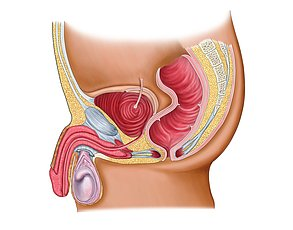Posted 30 July 2019
 Epididymitis is a
painful condition which affects men and has several causes, with a major cause
being sexually transmitted infections (STIs), particularly in men under the age
of 35. Most cases can be resolved with a course of antibiotics. (1)
Epididymitis is a
painful condition which affects men and has several causes, with a major cause
being sexually transmitted infections (STIs), particularly in men under the age
of 35. Most cases can be resolved with a course of antibiotics. (1)
What is epididymitis?
Epididymitis is the
medical term for inflammation of the epididymis, which is a tube which runs
along the back of the testicle. Both testicles have an epididymis and it is
possible for one or both to become inflamed. When the condition also affects
the testicles themselves, it can be known as epididymo-orchitis (orchitis means inflammation of the testicle(s)).
(1)
What are the symptoms of
epididymitis?
Epididymitis symptoms can
include:
- Pain in one or both testicles (the onset of epididymitis pain can be sudden or gradual)
- A painful, swollen, tender scrotum which can feel hot to the touch
- Fluid collecting around the testicle(s), giving a swollen or lumpy appearance and feel
- Trouble passing urine
- Discharge from the tip of the penis - this can be white, yellow or green, which signals an infection (1)
What are the causes of
epididymitis?
There are a number of
epididymitis causes, but the most common is an untreated STI - the main culprits being chlamydia and gonorrhoea - especially
in men under 35 years of age. A less common cause is a urinary tract infection
(UTI), which is rare in men. However, men are at higher risk of a UTI if they
have an enlarged prostate gland, a urinary catheter, or are recovering from
groin, prostate or bladder surgery. Even less commonly, epididymitis can be
caused by mumps, tuberculosis, injury to the groin area, Behçet's disease (an
autoimmune condition affecting the blood vessels), and can be a side effect of
the heart medication amiodarone. (1)
How is epididymitis
treated?
Epididymitis treatment in most
cases is a course of antibiotics. The aim of treatment is to clear up both the
primary infection (e.g. the STI or UTI) as well as
the associated epididymitis. It is important that the course is completed, even
if symptoms ease off - otherwise the infection will most likely persist and
symptoms will return. It can take as long as two weeks to feel completely
better.
Over-the-counter
painkillers can be used alongside antibiotics. Ibuprofen is the best choice
because of its anti-inflammatory action. A cold pack can also be applied to the
area to help soothe burning and inflammation.
Antibiotics for
epididymitis can be prescribed by your GP, but are also available from sexual
health clinics and, if the epididymitis is linked to chlamydia or gonorrhoea,
they can be purchased from Webmed Pharmacy.
Wearing supportive
underwear can also help to ease epididymitis pain. (1)
What is chronic epididymitis?
Chronic epididymitis is
inflammation of the epididymis that has persisted for a long time, and it may
come and go. The pain tends to be milder, but can be more widespread, affecting
the rest of the groin area and even the thighs and lower back. A cause is
rarely found. Chronic epididymitis treatment is most commonly a course of
anti-inflammatory drugs, usually ibuprofen taken for at least two weeks.
Occasionally, chronic epididymitis is caused by a long-standing infection and
can be treated with antibiotics. (2)
References
- The British
Association of Urological Surgeons. Chronic Epididymitis [cited 22 July 2019].
Available at: https://www.baus.org.uk/_userfiles/pages/files/Patients/Leaflets/Chronic%20epididymitis.pdf
Author
Gabby Gallagher MPharm
Medically reviewed by
Superintendent pharmacist Margaret Hudson
BSc(Hons) MRPharmS
30th July 2019
~
Posted in Men's Health